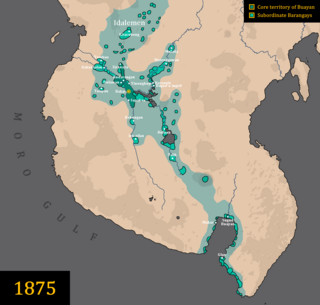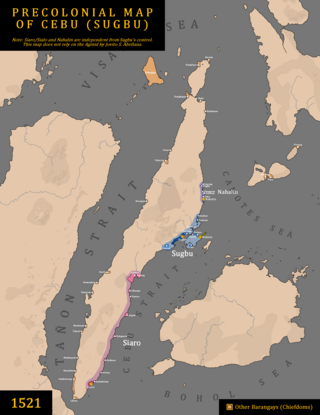Rajah or Raja is a monarch or princely ruler in South and Southeast Asia.
Contents
Rajah may also refer to:
- Rajah (comics), a fictional character in the Marvel Universe
- Rajah, an orange-striped tiger from Disney's Aladdin
Rajah or Raja is a monarch or princely ruler in South and Southeast Asia.
Rajah may also refer to:

General Santos, officially the City of General Santos, and abbreviated as GenSan, is a 1st class highly urbanized city in the region of Soccsksargen, Philippines. According to the 2020 census, it has a population of 697,315 people.

The Sultanate of Sulu was a Muslim state that ruled the Sulu Archipelago, costal areas of Zamboanga City and certain portions of Palawan in the today's Philippines, alongside parts of present-day Sabah, North and East Kalimantan in north-eastern Borneo.

Sulayman, sometimes referred to as Sulayman III, was a Crown Prince of the Kingdom of Luzon in the 16th century and was a nephew of King Ache of Luzon. He was the commander of Luzonian forces in the battle of Manila of 1570 against Spanish forces.

Islam in the Philippines is the second largest religion in the country, and the faith was the first-recorded monotheistic religion in the Philippines. Historically, Islam reached the Philippine archipelago in the 14th century, through contact with Muslim Malay and Arab merchants along Southeast Asian trade networks, in addition to Sufi missionaries from the Ba Alawi of Yemen from the Persian Gulf, southern India, and their followers from several sultanates in the wider Malay Archipelago. The first missionaries then followed in the late 14th and early 15th centuries. They facilitated the formation of sultanates and conquests in mainland Mindanao and Sulu. Those who converted to Islam came to be known as the Moros, with Muslim conquest reaching as far as Tondo that was later supplanted by Bruneian Empire vassal-state of Maynila.

Jolo, officially the Municipality of Jolo, is a 1st class municipality and capital of the province of Sulu, Philippines. According to the 2020 census, it has a population of 137,266 people.

Butig, officially the Municipality of Butig, is a 6th class municipality in the province of Lanao del Sur, Philippines. According to the 2020 census, it has a population of 22,768 people.

Shariff Aguak, officially the Municipality of Shariff Aguak, is a 3rd class municipality in the province of Maguindanao del Sur, Philippines. According to the 2020 census, it has a population of 33,982 people.

The Maguindanao people are an Austronesian ethnic group from the Philippines. The Maguindanaon are part of wider political identity of Muslims known as Moro, who constitute the third largest ethnic group of Mindanao, Sulu and Palawan. The Maguindanaons constitute the ninth largest Filipino ethnic group and are known for being distinguished in the realm of visual art. They have been renowned as metalworkers, producing the wavy-bladed keris ceremonial swords and other weapons, as well as gongs. The Maguindanaons historically had an independent sultanate known as the Sultanate of Maguindanao which comprises modern day Maguindanao del Norte, Maguindanao del Sur, Zamboanga Peninsula, Davao Region and Soccsksargen. The name "Maguindanao/Magindanaw" itself was corrupted by Spanish sources into "Mindanao", which became the name for the entire island of Mindanao.

The Sultanate of Maguindanao was a sultanate that ruled parts of the island of Mindanao, in the southern Philippines, especially in modern-day Maguindanao provinces, Soccsksargen, Zamboanga Peninsula and Davao Region. Its known historical influence stretches from the peninsula of Zamboanga to bay of Sarangani until Davao Gulf. During the era of European colonization, the Sultanate maintained friendly relations with British and Dutch traders.

The Sultanate of Buayan, alternatively the Rajahnate of Buayan, was a Muslim state on the island of Mindanao in the southern Philippines from the middle of the 14th to the 20th century. Buayan was one of the four major sultanates in Mindanao, other sultanates being the Sultanate of Sulu, the Sultanate of Maguindanao, and the Confederacy of Lanao. Being the primary power in the upper Cotabato valley, it had access to an abundance of fertile land as well as raw materials, transforming into an agricultural powerhouse in contrast to Maguindanao. In addition, despite its status as an interior sultanate, Buayan was able to conduct maritime trade and diplomacy either through the Pulangi river mouth, or its port in Sarangani. At its maximum extent, its territory stretched from modern-day Kabuntalan to Sarangani Bay.
Rajah Humabon, later baptized as Don Carlos Valderrama, was a King of Cebu in the 16th century.

In early Philippine history, the rank of lakan denoted a "paramount ruler" of one of the large coastal barangays on the central and southern regions of the island of Luzon.

Akí, also known as Rája Matandâ, was King of Luzon who ruled from the kingdom's capital Manila, now the capital of the Republic of the Philippines.

In Philippine history, the Tagalog bayan of Maynila was one of the most cosmopolitan of the early historic settlements on the Philippine archipelago. Fortified with a wooden palisade which was appropriate for the predominant battle tactics of its time, it lay on the southern part of the Pasig River delta, where the district of Intramuros in Manila currently stands, and across the river from the separately-led Tondo polity.

The known recorded history of the Philippines between 900 and 1565 begins with the creation of the Laguna Copperplate Inscription in 900 and ends with the beginning of Spanish colonization in 1565. The inscription records its date of creation in the year 822 of the Hindu Saka calendar, corresponding to 900 AD in the Gregorian calendar. Therefore, the recovery of this document marks the end of the prehistory of the Philippines at 900 AD. During this historical time period, the Philippine archipelago was home to numerous kingdoms and sultanates and was a part of the theorized Indosphere and Sinosphere.

The Rajahnate of Cebu or Cebu also called as Sugbu, was an Indianized Raja monarchy Mandala (Polity) on the island of Cebu in the Philippines prior to the arrival of the Spanish conquistadors. It is known in ancient Chinese records as the nation of Sokbu (束務). According to Visayan oral legend, it was founded by Sri Lumay or Rajamuda Lumaya, a minor prince of the Tamil Chola dynasty. He was sent by the Chola Dynasty emperor from southern India to establish a base for expeditionary forces, but he rebelled and established his own independent polity. The capital of the nation was Singhapala (சிங்கப்பூர்) which is Tamil-Sanskrit for "Lion City", the same rootwords with the modern city-state of Singapore.
Kapitan Laut Buisan, also known as Datu Katchil or Sultan Laut Buisan, was the sixth Sultan of Maguindanao in the Philippines. He was a direct descendant of Shariff Kabungsuwan, a Muslim missionary who preached Islam in the Philippines and established the sultanate after marrying a Sulu princess in the 16th century.

Malays played a significant role in pre-Hispanic Philippine history. Malay involvement in Philippine history goes back to the Classical Era with the establishment of Rajahnates as well as the Islamic era, in which various sultanates and Islamic states were formed in Mindanao, the Sulu Archipelago, and around Manila.
In the Philippine languages, a complex system of titles and honorifics was used extensively during the pre-colonial era, mostly by the Tagalogs and Visayans. These were borrowed from the Malay system of honorifics obtained from the Moro peoples of Mindanao, which in turn was based on the Indianized Sanskritized honorifics system in addition to the Chinese system of honorifics used in areas like Ma-i (Mindoro) and Pangasinan. The titles of historical figures such as Rajah Sulayman, Lakandula and Dayang Kalangitan evidence Indian influence. Malay titles are still used by the royal houses of Sulu, Maguindanao, Maranao and Iranun on the southern Philippine island of Mindanao. However, these are retained on a traditional basis as the 1987 Constitution explicitly reaffirms the abolition of royal and noble titles in the republic.